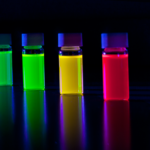Comparing the Color Gamut of QD and OLED Displays
Wide color gamut (WCG) is one of the primary selling points of modern display technologies, yet there is often a misconception about the purpose of WCG. In the field of Quantum dot (QD) and organic light-emitting diode (OLED) TVs, WCG is often bracketed with High Dynamic Range (HDR) which refers to the contrast ratios available for image reproduction. This blog post will explore the purpose of WCG in QD and OLED displays in more detail.
What is Wide Color Gamut?
Color gamut refers to the spectrum of colors that an electronic display can faithfully reproduce on-screen. As this property is concerned with wavelength distributions across the visible spectrum, it is measured in accordance with a standardized human perception of color. This information is used to determine the color spaces of a device within a CIE 1931 chromaticity diagram such as the Rec.709/sRGB.
The color gamut of a device is determined by the optical properties of the display architecture, including the brightness of the light-emitting component and the methods of color management or filtering used. Historically, cathode-ray tube (CRT) and liquid crystal displays (LCD) required a single RGB (red, blue, green) color gamut to accurately reproduce colors in the image content. The onset of high-definition displays significantly changed this dynamic.
Even high-definition technology has been outstripped by displays with 4K resolution, HDR, and WCG capabilities. WCG broadens the representation of colors on-screen with improved bit depth, providing more vibrant and realistic picture quality than was previously possible. Content produced for UHD displays with WCG capabilities is defined according to new standards such as DCI-P3 and Rec. 2020.
Rec.2020 Coverage with QD and OLED Displays
Rec.2020 is conceived as the next generation standard color space for display technologies, representing a spectral increase of 37% on DCI-P3 and 72% on Rec.709/sRGB. This is challenging for existing display technologies and content producers alike. Leading OLED displays that can reproduce up to 96 – 98% of DCI-P3 can replicate a maximum of 75% of Rec.2020.
QD displays are leading the way in terms of Rec.2020 coverage with unmatched peak brightness and color purity across up to 83% of Rec.2020. In fact, the sharp emission peaks of QD displays provides unparalleled color representation capable of reproducing as much as 93% of the visible colors in nature.
QD Display Technology with Avantama
Avantama is a nanomaterials and electronics manufacturer that specializes in engineering novel materials for display applications. Our Cadmium-free QDs are RoHS compliant and are suitable for multi-ton scale production through a range of cutting-edge printing methodologies.
If you would like any more information about our QDs, please do not hesitate to contact us.

